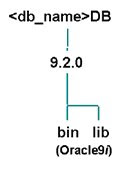Oracle Applications 11i File system
Depending on how you chose to install Applications, these product directories may be located on a single machine (the simplest case) or on multiple machines (the most common type of deployment). Operating system environment settings indicate the location of the various files in the file systems of the database and application server machines.
Note:
• The DATA or DATA_TOP directory is located on the database server machine, and contains the system tablespaces, redo log files, data tablespaces, index tablespaces, and database files.
• The DB directory is located on the database server machine, and contains the ORACLE_HOME for the Oracle9i database.
• The APPL or APPL_TOP directory contains the product directories and files for Oracle Applications.
• The ORA directory contains the ORACLE_HOMEs for the Applications technology stack components.
• The COMN or COMN_TOP (or COMMON_TOP) directory contains directories and files used across products.

The DATA Directory
The DATA file system contains the data (.dbf) files of the Oracle database. Rapid Install installs the system, data, and index files in directories below several mount points on the database server. You can specify the directory names of the mount points on the database server during installation.
DB and ORA Directories
Oracle Applications supports employing an Applications database of one version, while linking Applications programs using the tools from a second or third version of the database. This multiple ORACLE_HOMEs configuration allows new features of the database to be supported, while maintaining compatibility with earlier releases.
Release 11i utilizes three ORACLE_HOMEs:
1. The 9.2.0 ORACLE_HOME (Applications database home) is located in the DB directory. It contains the files needed for running and maintaining the Oracle Applications database.
2. The 8.0.6 directory contains the ORACLE_HOME for the Developer 6i products (Forms, Reports, and Graphics). The product libraries in the 8.0.6 ORACLE_HOME are used to relink Oracle Applications executables.
3. The iAS directory, also under the ORA, contains the ORACLE_HOME for Oracle9i Application Server.
The APPL Directory
Oracle Applications files are stored in the APPL directory, which is known as the APPL_TOP directory.
The APPL_TOP directory contains:
1. The core technology files and directories.
2. The product files and directories (for all products).
3. The main applications environment file, called .env on UNIX, and .cmd on Windows. 4. The consolidated environment file, called APPS.env on UNIX, and APPS.cmd on Windows.

Each product has its own subdirectory under APPL_TOP, and the Oracle Applications base release is typically reflected in the subdirectory name. For Release 11i, the base release is
11.5.0.
The directory path for a particular product is defined by the value of the environment variable
• APPL_TOP=/d01/prodappl
• AU_TOP= /d01/prodappl/au/11.5.0
• FND_TOP = /d01/prodappl/fnd/11.5.0
• INV_TOP= /d01/prodappl/inv/11.5.0
All Oracle Applications products, regardless of license status, are installed in the database and the file system. Files for unlicensed products should not be removed. Conversely, multiple releases and product versions must not be installed under a single APPL_TOP directory.
The same principle applies to all directories, apart for the admin directory.
Product Directories
Each Oracle Applications product directory contains numerous subdirectories, which are used to group the various types of file used by the product. Not all products have all the sub-directories shown on the slide. There may also be differences depending on installation choices.

Additional Language Subdirectories
Translated forms files, reports files, and installation scripts are all stored in their own language specific directories. These directories are identified by a language directory code.
For example, all forms files located under the US directory are in American English, while all forms files located under the AR directory are in Arabic.
Message files are not stored in language-specific directories. Instead, message files are named according to the language of the messages they contain. For example, AR.msb is a file containing messages translated to Arabic.

AU Directory
Applications Utilities (AU) are product files that are consolidated in a single location for optimal processing.
These files include:
• PL/SQL libraries used by Oracle Reports, in the PLSQL subdirectory.
• PL/SQL libraries used by Oracle Forms, in the resource subdirectory.
• Oracle Forms source files, in the forms subdirectory.
• A copy of all Java files used by JInitiator when regenerating the desktop client JAR files, in the java subdirectory.
• Certain reports needed by products such as Discoverer, in the reports subdirectory.

Common Components Directory - COMMON_TOP
The db_name
The COMMON_TOP/admin directory is the default location for the concurrent manager log and output directories. When the concurrent managers run Oracle Applications reports, they write the log files and temporary files to the log subdirectory of the admin directory (COMMON_TOP/admin/log) and the output files to the out subdirectory of the admin directory (COMMON_TOP/admin/out).
By default, the top-level directories for both Java (JAVA_TOP) and HTML (OAH_TOP) are both under COMMON_TOP.

Applications Technology Stack Directory - (db_Name)
This multiple ORACLE_HOMEs configuration allows new features of the database to be supported, while maintaining compatibility with earlier releases.
Release 11i utilizes two ORACLE_HOMEs under the (db_Home)
• The 8.0.6 directory contains the ORACLE_HOME for the Developer 6i products (Forms, Reports, and Graphics). The product libraries in the 8.0.6 ORACLE_HOME are used to relink Oracle Applications executables. This is the base Oracle home, which contains SQL*Plus and other database utilities used by Auto Patch.
• The iAS directory contains the ORACLE_HOME for Oracle9i Application Server, which includes the Oracle HTTP server.
 Database Technology Stack Directory - (DB_NAME)
Database Technology Stack Directory - (DB_NAME)The database server is located in its own directory structure, with its own ORACLE_HOME.The 9.2.0 ORACLE_HOME (Applications database home) is located in the
 p>Note: Oracle Applications releases prior to 11.5.9 were packaged with Oracele8i. Releases 11.5.9 and 11.5.10 are packaged with Oracle9i, and can optionally be used with the Oracle 10g database server.
p>Note: Oracle Applications releases prior to 11.5.9 were packaged with Oracele8i. Releases 11.5.9 and 11.5.10 are packaged with Oracle9i, and can optionally be used with the Oracle 10g database server.